-
Car Reviews
- All reviews
- Midsize SUVs
- Small cars
- Utes
- Small SUVs
- Large SUVs
- Large cars
- Sports SUVs
- Sports cars
- Vans
Latest reviews
- Car News
-
Car Comparisons
Latest comparisons
- Chasing Deals
Mazda’s first ‘premium’ SUV is now a firm favourite among Australians seeking a stylish compact crossover at a reasonable price

Though the Mazda CX-30 sits between the city-sized CX-3 and midsize CX-5, it’s no CX-4: instead, the shift to two digits in the name signifies that this crossover is a “Mazda Premium” product.
This brand’s evolving premium pitch means pretty much what you’d expect: increasingly lush interiors, a quiet and comfortable ride, and shapely, expensively-made exterior designs. In other words, Mazda sees itself as knocking on the door of the luxury segment.
And the CX-30 is just the start of Mazda’s premium crossover push. Later, a CX-50 will follow that, like this model, takes a significant stride upmarket while being usefully roomier than its single-digit sibling.
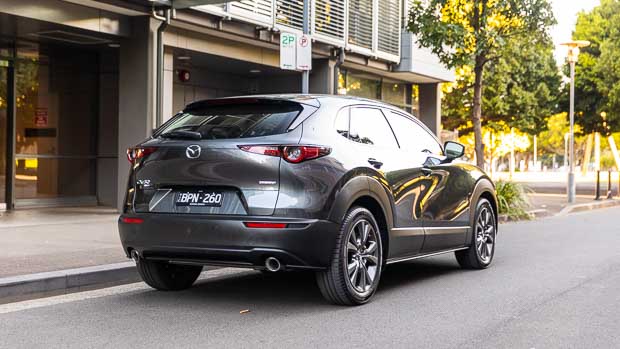
However, while the 2021 Mazda CX-30 is unabashedly premium in its design, it’s not all that expensive – at least at the lower span of the range. The recently-updated Pure base model costs around $35,000 on the road and offers nearly as good an experience as the circa-$50,000 driveaway Astina grades.
Naturally, as you work your way up the range the CX-30 provides more and more creature comforts – picture leather-lined electric memory seats with heating, a Bose stereo, a sunroof and all the available safety tech on the range-topping X20 Astina that was the basis for this test.
But while Mazda sell the CX-30 in Australia with three engines, there is no true flagship powertrain – something that holds this crossover back from truly pushing into the realm of the near-luxurious.
The first big choice when buying a CX-30 requires you to pick an engine. There are three, with the middle motor offering the choice between front-wheel drive and all-wheel drive.
The base G20 is a two-litre petrol four-cylinder engine shared with the Mazda 3 hatch and MX-5 roadster producing, in this case, 110kW of power and 200Nm of torque in front-drive only. A manual is available on the least expensive Pure spec though other trims come with an auto as standard.
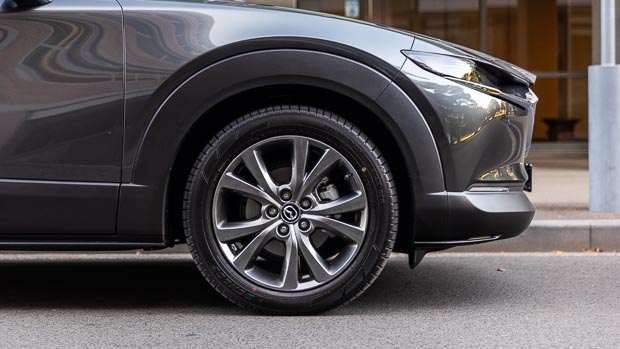
There is no avoiding that the G20 needs a rev but its MX-5 origins guarantee it sounds sweet when pushed and there actually is ample torque here to get the job done.
That said, buyers seeking an engine which is adequate rather than slightly strained will prefer the 2.5-litre G25 that produces a healthy 139kW of power and 252Nm of torque. There’s still no turbo, unlike the Skoda Karoq, Toyota C-HR or Volkswagen T-Cross, but it’s quick enough for most anybody.
Should you frequently travel on snow- or gravel-covered tracks you could consider the $2,000-optional all-wheel drive for the G25, though few will truly need this in a small SUV.
Sitting alone at the very top of the CX-30 tree is the AWD-only X20 Astina, which utilises Mazda’s very novel spark-controlled compression-ignition Skyactiv-X motor. Technologically, the X20 is fabulous and innovative, though in the CX-30, the real-world fuel savings of about 6 per cent don’t justify the $3,000 impost over a G25.
What the CX-30 lineup is missing in Australia is twofold. First, there is no truly strong hybrid to compete with Toyota’s lineup of small and midsize SUVs.
Secondly, Australia sadly misses the US market’s optional 2.5-litre turbo petrol, which produces a stout 186kW/430Nm – that would be sufficient to easily catapult the CX-30 to the performance end of this class.
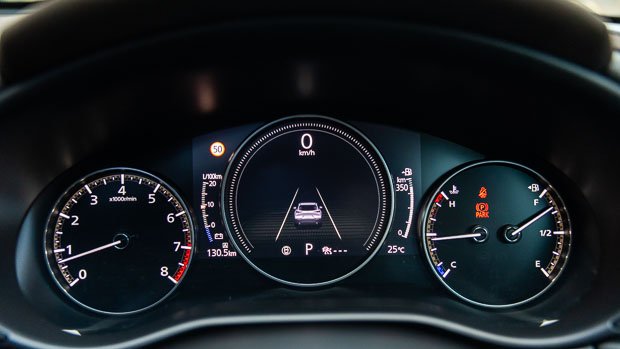
That said, working with what the CX-30 has in Australia in the engine department – it’s still a relative pleasure to drive compared to the thrashy, thirsty atmospheric petrols standard in a Hyundai Kona, Kia Seltos or Honda HR-V.
Mazda’s famed high-compression petrol engines deliver more torque than most naturally aspirated donks at low revolutions, meaning they don’t need to be worked quite as hard.
Turbocharging would ease progress further, but Mazda’s superb automatic gearbox tuning now (belatedly) carries across to the six-speed unit utilised by the CX-30. The logic felt buggy when this SUV first launched but it’s now near-flawless.
Equally, the ride and handling of the CX-30 is better than most small SUVs, even if we wish Mazda had dialled in a touch more refinement in the front suspension – when encountering square edges common to Sydney concrete roads there’s too much of a crash transmitted to the cabin.
Absent that particular type of surface change, though, the CX-30 confidently damps out imperfections in the road and is a particularly settled country cruiser, taking undulations, cracks and potholes in its stride – and without the adaptive dampers some rivals need to feel competent on Australian B-roads.
It’s worth noting that the G20 Pure base model, which rides on much chunkier tyres and 16-inch wheels, has the best ride quality of the range by far. The lower-profile tyres wrapped in 18-inch wheels of every other trim seem to be the culprit behind the concrete-road insolence.
The steering ratio is not especially quick but you rapidly build a level of fluency in the CX-30 – this SUV likes to string corners together and feels intuitive doing it. Grip levels from the Dunlop rubber are acceptable; with a stickier tyre the CX-30 would probably be described as sporty.
Refinement levels are very high for the mainstream small SUV class, with the CX-30 following the current Mazda 3, Mazda 6, and CX-9 SUV in demonstrating really hushed interiors.

Like the transmission, earlier examples of the CX-30 sported fussy tuning of the forward collision warning system – this has been removed and the safety features now feel more tightly integrated.
The adaptive cruise control still wanders up to 5km/h over or under the given speed, which is not acceptable, but the lane keep assist is well-tuned, the blind-spot monitoring is subtle (once you switch it to visual cues only) and like all Mazda SUVs, reversing AEB is standard.
Optional on some grades and standard on Astina is an expanded safety package that adds a useful 360-degree camera as well as low-speed piloting assist that will hold the centre of the lane in a traffic jam. Also added is front cross-traffic alert, which works well.
Many buyers will be seduced by the CX-30 before even leaving the dealership forecourt – so impressive is the cabin of this small SUV.
Propelling the Mazda to the top of its class for static appeal, the Mazda Premium cabin adopted in the CX-30 is lined in leather and leather-like surfaces for an impression that is more like Japanese luxury marque Lexus than direct rival Toyota.
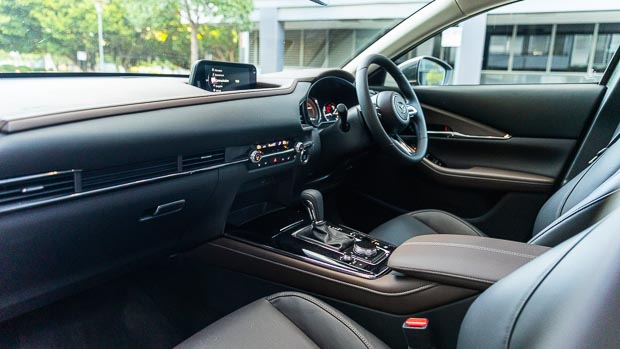
You sit down into the CX-30 – it’s a distinctively sportier driving position than a Kona or Qashqai – while your eyes take in a deep, beautifully upholstered dashboard.
The colour schemes may not suit everybody: high-spec CX-30 variants have a dark brown hue to the dash and doors, while base cars have navy blue trim – but there is no debating that this a visual feast.
And, for the most part, it feels good as well. The steering wheel is encased in soft and creamy leather while the vast dash surface is soft and yielding. Sure, you might not actually touch the dashboard often but being soft – and not shiny – it soaks up light and sound.
Both armrests sit at a perfect height, making this a relaxing vehicle to drive for long distances … apart from the seats, which lack adequate support for long-legged drivers. An aching thigh set in after a couple of hours in the saddle.
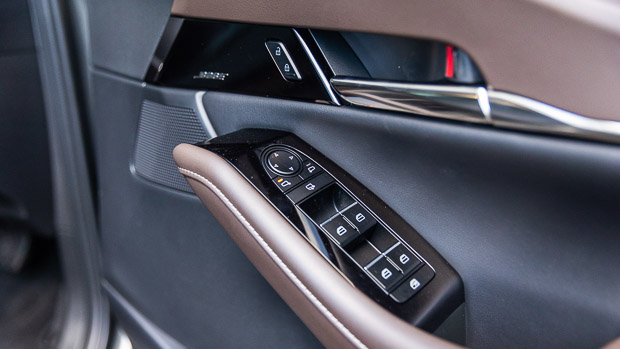
An adjustable leg extender would take care of this because, for the most part, the electrically-adjustable, heated driver’s seat of the Astina is comfortable – as is the manually-adjustable cloth seats of lower variants which feature mechanical thigh angle adjustment. Nice touch, Mazda!
For new Mazda models the decision has been taken to abandon touchscreens, with the brand claiming operation of the deep-set 8.8-inch central display is safer via a rotary dial in the centre. We tend to agree, and the screen – plus the new-ish software it runs – is intuitive to use.
The navigation and media graphics are noticeably more sophisticated than previous-gen Mazdas, including the smaller CX-3 and larger CX-5. There is wired Apple CarPlay and Android Auto … though it should be noted Volkswagen and Skoda offer the same tech, sans-wires.
And while there is a crisp, punchy Bose stereo, you will not find wireless smartphone charging or new-style, faster-charging USB-C ports in here, making the CX-30 cabin feel slightly dated on the technology front.
Further improvement could be made in the instrument cluster, where handsome analogue dials flank a digital screen displaying … a graphical rendition of an analogue speedo, which is fairly useless. Integrating a map in this display, akin to the Audi Q2, would be better.
Moving to the back seats reveals that Mazda are quickly adopting superior packaging in their smaller vehicles. Admittedly, the CX-30 is 12cm longer than the tiny CX-3, but rear space is way up, with a deep and comfortable bench supplemented by very decent legroom for the small SUV class.

Air vents are standard in the rear. The windows are on the smaller side – though nowhere near as gaol-esque as the Toyota C-HR’s unfortunate second row – but you do get a plush central armrest. The door skins revert to hard in Row 2.
Perhaps that deep rear bench came at the expense of boot space, which continues to be something of a problem for Mazda. Measuring just 310 litres, the CX-30’s boot struggled to accommodate our trio of suitcases – even the smaller Skoda Kamiq is much roomier in the cargo area.
Still, you nab a space-saver spare and when you fold the rear seats flat, the CX-30 is relatively accommodating of longer objects.
Unlike some rivals which can travel up to 15,000km between scheduled services, Mazda require maintenance every 10,000km, which is slightly inconvenient. The timing interval is still 12 months.
It costs about the same amount to service any of the CX-30’s engines. The first 5 services (so, 5 years/50,000km) are slated to set you back $1,670 for the G20 motor, $1,700 for the G25 and $1,785 for the Skyactiv-X X20.
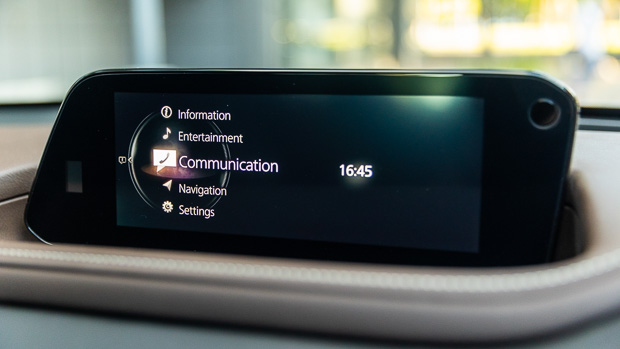
Working out to around $340 per visit, those prices are fairly average for the small SUV segment – but again, some competitors give you more distance between maintenance.
The Mazda CX-30 is covered by a five year, unlimited kilometre warranty that is becoming the expected guarantee in the Australian car industry.
Fuel consumption has averaged 9L/100km in the real world in our testing of both the G20 and G25 petrol engines, while the innovative X20 powertrain cuts that consumption to around 8.5L/100km in combined driving.
The CX-30 is a bold move into premium crossover territory for Mazda.
While the upmarket Astina grade makes the premium point more clearly than any other variant, the fact is that Mazda have sprinkled magic across the whole lineup.
In many ways, the entry-level Pure – recently updated to bundle a leather steering wheel and gear shifter – is the best distillation of the CX-30’s philosophy.

You get a well-made interior with the best ride quality of the range thanks to the smaller alloys and chunkier tyres, and while the G20 engine isn’t fast, it is very willing.
That said, we also see the appeal of a G25 Astina, with its heated front seats with driver’s memory, crystal-clear Bose stereo and open-air sunroof.
Should Mazda increase the distance allowed between services, further refine the ride on 18-inch wheels and add useful wireless smartphone mirroring, the CX-30 will solidify its enviable position in the small SUV segment.
Variant tested X20 ASTINA (AWD) M HYBRID
Key specs (as tested)
About Chasing cars
Chasing Cars reviews are 100% independent.
Because we are powered by Budget Direct Insurance, we don’t receive advertising or sales revenue from car manufacturers.
We’re truly independent – giving you Australia’s best car reviews.
The estimate provided does not take into account your personal circumstances but is intended to give a general indication of the cost of insurance, in order to obtain a complete quote, please visit www.budgetdirect.com.au. Estimate includes 15%^ online discount.
^Conditions Apply
Budget Direct Insurance arranged by Auto & General Services Pty Ltd ACN 003 617 909(AGS) AFSL 241 411, for and on behalf of the insurer, Auto & General Insurance Company Limited(ABN 42 111 586 353, AFSL 285 571).Because we don’t know your financial needs, we can’t advise you if this insurance will suit you. You should consider your needs and the Product Disclosure Statement before making a decision to buy insurance. Terms and conditions apply.
Indicative quote based on assumptions including postcode , 40 year old male with no offences, licence suspensions or claims in the last 5 years, a NCD Rating 1 and no younger drivers listed. White car, driven up to 10,000kms a year, unfinanced, with no modifications, factory options and/or non-standard accessories, private use only and garaged at night.
^Online Discounts Terms & Conditions
1. Discounts apply to the premium paid for a new Budget Direct Gold Comprehensive Car Insurance, Third Party Property Only or Third Party Property, Fire & Theft Insurance policy initiated online on or after 29 March 2017. Discounts do not apply to optional Roadside Assistance.
2. Discounts do not apply to any renewal offer of insurance.
3. Discounts only apply to the insurance portion of the premium. Discounts are applied before government charges, taxes, levies and fees, including instalment processing fees (as applicable). The full extent of discounts may therefore be impacted.
4. We reserve the right to change the offer without notice.